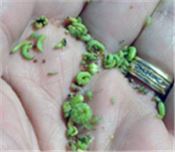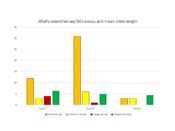|
Weevil Watch
DR. LEE TOWNSEND
LEXINGTON, KY.
Alfalfa weevil populations are continuing to develop with mostly small larvae (less than 1/8 inches long) (Figure 1) collected in sweep samples taken from 4- to 6-inch alfalfa in three Fayette county fields on March 24, 2017.
While not an effective assessment tool to determine the need for an insecticide treatment, sweep net collections can give some useful information about weevil populations (Figure 2). Samples taken on March 24 show the range and comparative size of larval numbers in three fields on the UK Spindletop Experiment Station Farm.
Here are some points to consider
• Fields 1 and 2 were adjacent established fields with good stands of alfalfa. While there were no readily apparent differences, the total larvae per 30 sweeps from each field were 17 and 37, respectively. This emphasizes the need to check each field because insect infestations may vary from field to field.
• Most of the weevil larvae collected were very small (less than 1/8-inch long). It takes close inspection to catch the pin-holes chewed into tender tip foliage by these small larvae.
• The damage potential from alfalfa weevil is based on larval numbers and plant height. Stem length is still relatively short so fewer grubs are needed to affect yield and quality. Taller plants can tolerate a heavier weevil load. Watch alfalfa while it is still in the vulnerable range.
Field 3
Field 3 is a very different situation. This alfalfa stand has declined significantly and purple deadnettle is thriving. The sparse stand may not have attracted many adult weevils during their fall return flight to alfalfa.
Continue the Weevil Watch
The next 2 weeks should tell the tale in terms of the 2017 weevil population. Continue the weevil watch. While the 30-stem sampling method provides an excellent means of assessing the need for treatment, the percentage of infested tips provides an alternative method. This approach recommends treatment if 25 percent to 50 percent of the alfalfa tips have feeding damage and there are two or more live larvae per stem.
If weevil numbers or damage are sufficient to warrant an insecticide application, the current degreeday accumulation for your location can help to determine a rate. This information is available at Calculating Degree Days website. Use a medium residual (mid-rate) insecticide if the accumulation is in the range 276 to 375. Use a short residual (low rate) if the accumulation is 376 or greater but harvest in not imminent. ∆
DR. LEE TOWNSEND: Extension Entomologist, University of Kentucky

Figure 2. Alfalfa weevil larvae per 30 sweeps and mean stem length from three
Fayette County fields sampled March 24, 2017.

Figure 1. Mainly small alfalfa weevil larvae have been collected in sweep nets.
Photo: Lee Townsend, UK
|
|